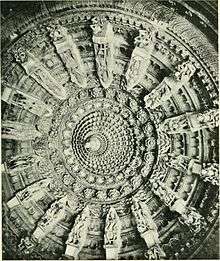Vividha Tirtha Kalpa
Vividha Tirtha Kalpa is a widely cited [1][2][3]Jain text composed by Jinaprabha Suri in the 14th century CE. It is a compilation of about 60 Kalpas (sections), most of them give the accounts of major Jain Tirthas.

Vividha Tirtha Kalpa is an example of the tirtha-mala texts that are compilations about Jain Tirthas throughout India, ranging from Nirvana Kanda of Kundakunda to modern publications.
Jinaprabh Suri is said to have written three Jain prayers in Persian.[4]
Author
Jinaprabha Suri lived during the rule of Muhammad bin Tughluq. He travelled widely and has left a record of contemporary events as well as oral traditions. He was born in Mohilvadi, Gujarat in the Tambi clan of Shrimal Jain community. He was initiated at the age of 8 and became an Acharya in Kharatara Gaccha at 23.
Composition time
Some of the Kalpas contain the date of compositions, although most are undated. The dates range from Samvat 1364 (Vaibhargiri Kalpa) to Samvat 1389.[5] The last section of the book was written in 1332 CE in Delhi during the rule of Muhammad Bin Tuglaq.
Contents
_Gopuram.jpg)
The tirthas mentioned cover regions (as divided by Muni Jinavijaya):
- Gujarat and Kathiawad
- Punjab and Uttar Pradesh
- Maharashtra
- Rajasthan and Malava
- Eastern UP and Bihar
- Karnataka and Telangana
The description suggests that at that time, while the Shwetambara- Digambara division had become distinct, the tirtha were visited by Jains of both sects. He describes the building and destruction of many temples in recent period.
See also
Notes
- ↑ Jaina Iconography, Volume 1 of Jaina-rūpa-maṇḍana, Umakant Premanand Shah, Abhinav Publications, 1987, p. 198
- ↑ Cort, J. (1987). Medieval Jaina Goddess Traditions. Numen, 34(2), 235-255
- ↑ Balbhadra Jain, Bharat ke Digambar Jain Tirth, Bharatiya Jnanapitha, 1974
- ↑ Audrey Truschke, Jains and the Delhi Sultanate, JAINpedia, 2015
- ↑ Vividha Tirth kalpa, Jinaprabha Suri, Hindi Translation by Bhanwarlal Nahta, Shri Jain Shvetambar Nakoda Parshvanath Tirtha, 1978